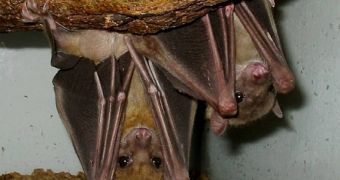This mysterious virus can kill you in just one week while you're experiencing jaundice, pancreatitis, weight loss, delirium and neuropsychiatric symptoms, hemorrhaging, hypovolemic shock and multi-organ dysfunction with liver failure and even external hemorrhaging from bodily orifices, just like in Ebola. 23-25% of the infected die, sometimes with life consequences and there is no cure against it.
Till now it was not even known where it came from. Now an international team found Marburg virus RNA genome and antibodies in a common species of African fruit bat, the Egyptian fruit bat (Rousettus aegyptiacus), solving a question that haunted the researchers for long and which produced much speculation.
The deadly disease had long baffled epidemiologists, ecologists and virologists, till this recent collaboration between the Centers for Disease Control and Prevention (CDC), Atlanta, GA and the Centre International de Recherches M?dicales de Franceville (CIRMF) and the Institut de Recherche pour le D?veloppement, Franceville, Gabon.
"Identifying Marburg infection in the African fruit bats brings us one step closer to understanding this deadly disease," said co-author Dr. Eric Leroy of CIRMF.
Marburg virus and its close relative, the Ebola virus, have produced large outbreaks among a high number of victims (in some areas up to 80-90%) in humans and great apes (gorillas and chimps) and by now, there is no available vaccine or cure.
The virus was found in 4 out of 283 R. aegyptiacus bats, out of 1100 tested bats, assigned to 10 species, trapped between 2005 and 2006 near caves in Gabon and the Republic of Congo. 29 of the Egyptian fruit bats were also serologically positive for Marburg virus, carrying IgG antibodies in their blood serum, but neither Marburg virus RNA nor specific antibody were found in any of the other checked species of bat.
RNA got from the infected bats has unique stretches compared to other known Marburg virus strains. The Egyptian fruit bat is widely spread across sub-Saharan Africa, northern Africa and Middle East to northern India.
"From a public health perspective, this discovery offers us new insight into the transmission of Marburg virus and potentially other filoviruses," said lead author Dr. Jonathan Towner, senior microbiologist at the CDC. Recent reports have signaled an outbreak of Marburg infection among Ugandan miners.

 14 DAY TRIAL //
14 DAY TRIAL //